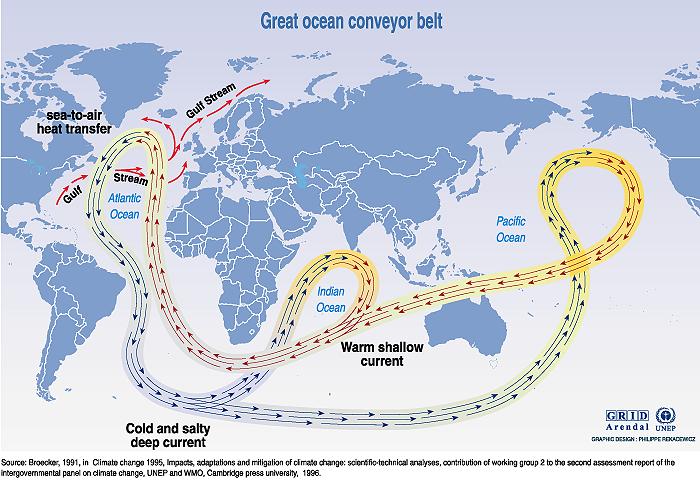THERMOHALINE CIRCULATION
Thermohaline circulation, how it works
If you look at a globe, you’ll see that the latitude of much of Europe and Scandinavia is the same as that of Alaska and permafrost-locked parts of northern Canada and central Siberia. Yet Europe has a climate more similar to that of the United States than northern Canada or Siberia. Why? It turns out that our warmth is the result of ocean currents that bring warm surface water up from the equator into northern regions that would otherwise be so cold that even in summer they’d be covered with ice.
Currents carrying colossal amounts of water transport it around the globe, by what has been named "The Great Ocean Conveyor" (Broecker, 1991). Oceanic thermohaline -- so named because it involves both heat, hence "thermo," and salt, hence haline, for common table salt (halite) -- circulation is what drives the Conveyor. The two attributes, temperature and salinity, determine the density of seawater, and the differences in density between the water masses in the world's oceans causes the water to flow. Thermohaline circulation -- the Great Ocean Conveyor -- thereby produces the greatest oceanic current on the planet. It works in a fashion similar to a conveyor belt -- hence the name -- transporting enormous volumes of cold, salty water from the North Atlantic to the Northern Pacific, and bringing warmer, fresher water in return.

Thermohaline Circulation - TC
Descriptions of the working of the Conveyor usually start with what happens in the North Atlantic, under and near the polar region sea ice. There warm, salty water that has been transported north from tropical regions is rapidly cooled, forming frigid water in vast quantities. When this seawater freezes, its salt is excluded (sea ice contains almost no salt), increasing the salinity of the remaining, unfrozen water. This salinity makes the water quite dense, and its frigidity makes it denser still. Being denser than the less saline, warmer surface waters moving in from the south, this water drops to the floor of the ocean. This water is known to oceanographers as North Atlantic Deep Water (NADW), and it propels today's oceanic thermohaline circulation. The critical points of the "Conveyor Belt” are where surface waters sink into the deep ocean. This happens only in a few places – along the Antarctic shelf and at two sites in the North Atlantic (the Labrador Sea and the Nordic Seas).

North Atlantic Deep Water – NADW
In the northernmost reaches of the North Atlantic, this water begins a great circuit through the world's oceans. First it moves south through the North Atlantic, then south through the South Atlantic, rounding Brazil, and then encounters great masses of similarly frigid and saline water coming from under the sea ice area surrounding Antarctica (called Antarctic Bottom Water [AABW] or Antarctic Deep Water [AADW]), hugging the ocean bottom as it flows. This greatest of ocean currents then moves east, well north of the Antarctic mainland but well south of Africa (where, past the Cape of Good Hope, a branch pushes northward along the east African coast) and continues east across the entire breadth of the Indian Ocean north of Antarctica, swings around south of Australia and far into the Pacific. As it continues on its submarine migration, the current mixes with warmer water, warms, and rises, until finally, in the northern Pacific, it dissipates as a coherent entity.

Antarctic Bottom Water – AABW
In the Pacific, however, a warm, shallow-sea counter-current has been generated. This counter-current moves south and west, wends its way through the Indonesian archipelago, across the Indian Ocean, still heading west, and rounds southern Africa just off the Cape of Good Hope. It crosses though the South Atlantic, still on the surface (though it extends a kilometer and a half -- almost a mile -- deep), where tropical warmth increases evaporation and leaves the counter-current saltier. It then moves up along the East Coast of North America, and on across to the coast of Scandinavia, which its warmth helps protect from the extreme cold of northern winters. When this warmer, saltier water reaches high northern latitudes, it chills, and eventually becomes North Atlantic Deep Water, completing the circuit.
Although this global thermohaline circulation has been vigorous since the end of the ice age, the global conveyor is vulnerable to significant and rapid changes. Because the circulation is driven by the varying densities of water, it can become sluggish, or perhaps even stagnant, when those densities change. At times, frigid deep water from Antarctica has been the dominant driver of the world's circulation, which results in the cooling of surface waters in the North Atlantic and lower temperatures for coastal North America and northern Europe (Broecker, 2001). During the Ice Age, the primary driving force of global thermohaline circulation may have switched back and forth between the waters of the North Atlantic and those of Antarctica. As the deep water driver seesawed between north and south, it produced rapid shifts of temperature for the North Atlantic region and significant climate instability (Broecker, 1997).
The density of tropical water is also quite high, though not as that of polar water. It owes this high density to the elevated rate of evaporation in tropical areas. As with the freezing of polar sea ice, evaporation leaves the salt behind in the remaining seawater. (Both freezing and evaporation therefore produce higher salinity in surface water. Being denser than the surrounding water, tropical water sinks, though because polar water is much colder and therefore denser, it sinks faster and deeper than tropical water.)


